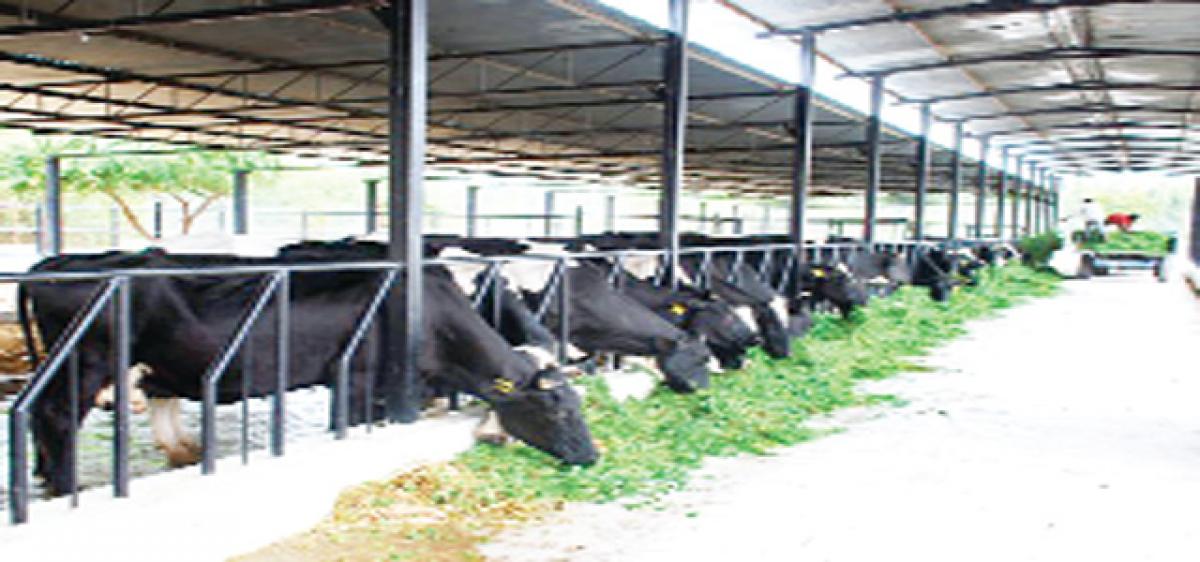Live
- Black Friday 2024: Top Gadget Deals You Can’t Miss – iPhone 16 for Rs 72,900 and More
- Some politicians attempting to divide Hindus for votebank: Former UP Minister
- Bangladesh's Deposed PM Sheikh Hasina Condemns Arrest of Hindu Leader Chinmoy Krishna Das, Demands Immediate Release
- Telangana DGE Revises SSC Exam Fee Payment Schedule for 2025
- ESA Proba-3 Mission Launch on ISRO's PSLV-XL Rocket: December 4, 2024
- MP Priyanka’s debut: Posts featuring Rahul, Kharge win hearts on social media
- 2025 Bollywood Movie Release Dates: Shahid Kapoor’s Deva in January to Alia Bhatt’s Alpha in December
- Shivraj Chouhan tells officials to ensure farmers get high quality fertilisers, seeds and pesticides
- Preamble of Constitution describes India’s collective spirit: Gopalkrishna Gandhi at Constitution Day lecture at JGU
- Centre to offload 25 lakh tonnes of wheat in open market to bring down price
Just In

Mumbai (IANS): Global warming portends ill for the country’s flourishing dairy sector that stands to lose a whopping three million tonnes of milk in the next three years as average temperatures increase, with wide fluctuations in day and night temperatures, industry
Mumbai (IANS): Global warming portends ill for the country’s flourishing dairy sector that stands to lose a whopping three million tonnes of milk in the next three years as average temperatures increase, with wide fluctuations in day and night temperatures, industry experts warned.
Addressing the ongoing three-day ‘45th Dairy Industry Conference,’ themed ‘Climate Change and Dairying,’ several industry leaders and experts discussed how the gradually warming climate is adversely hitting the country's dairy industry that employs over 16 million farmers, including 4.60 million women.
Arun D. Narke, President of Indian Dairy Association, said that “India is self-sufficient in milk and is ranked the world’s largest producer with an annual production of 156 million tonne (2015-2016).
Citing the Ministry of Agriculture figures, he said Indian farmers are adding around 10 million tonnes of milk annually with a compounded annual growth of around 6.5 per cent in the sector, largely from farmers owning an average of one or two milch cows, to make the ‘White Revolution’ a success.
However, this milk production could go down by three million tonne over the next three years as the average temperatures rise, creating problems of water and availability of green and dry fodder for the cattle, he said.
Indian Dairy Association (West Zone) Chairman Arun D. Patil said that Maharashtra has already undergone three consecutive years of drought till this year, which is set to affect the entire agriculture sector, including dairy.
Patil said most of India’s water needs are met through monsoon rains, which remained deficient for three years in a row, resulting in rising prices of fodder and increased cost of milk production.
He urged the government to procure milk at a fixed price determined by the Centre as in the case of other agricultural commodities, like cotton or sugarcane, to enable the milk farmers get a minimum support price.
The industry has already initiated aggressive measures to deal with the upcoming crisis, farmers have started raising levels of animal shelters and scientists are researching on how to enhance the shelf-life of milk.
In this connection, AK Srivastava, Director and Vice Chancellor, Indian Council of Agricultural Research-National Dairy Research Institute (ICAR-NDRI), said even if we can achieve an increase in shelf-life of milk by half an hour, it would lead to massive profits to the dairy sector.
“The biggest challenge to the global dairy industry is expected between 2070-2090 when the temperatures are expected to rise between 2 degrees and 7 degrees,” predicted Srivastava grimly.
Additionally, he said, the Indian dairy sector faces huge shortage of skilled manpower with sound technical expertise in understanding the need for handling of milking cattle and related issues.
National Dairy Development Board (NDDB) Chairman Dilip Rath said that India accounts for 18 per cent of the global milk production, which is growing at around 6.5 per cent annually as compared to 4.7 per cent over the previous 10-year period.
“Milk is India’s single-largest agricultural commodity in value terms and is more than the combined value of paddy and wheat put together. The per capita availability of milk has increased three-folds, from 112 gm per day in 1970-1971 to 337 gm per day in 2016-2016.”
“The country’s milk demand is likely to increase by 190 million tonne by 2020 and catering to it poses a challenge with reducing farmlands and other issues,” Rath pointed out.
The conference welcomed the government's initiative to allocate Rs 8,000 crore for three years for the growth and development of the dairy industry.
The three-day conference and exhibition, which got underway on February 16, has attracted 65 experts and 180 exhibitors from Indian, the USA, the UK, Germany, China, Bulgaria, Denmark, Finland, France, Italy, Lithuania, Malaysia, The Netherlands and Thailand, showcasing products, technologies and services.

© 2024 Hyderabad Media House Limited/The Hans India. All rights reserved. Powered by hocalwire.com







